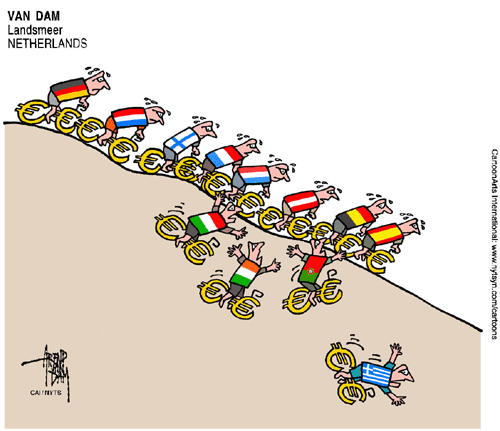Crossposted from The Stars Hollow Gazette
Monday Business Edition
That, dear readers, is the interest rate the United States is paying on it’s 10 year Treasuries today after the downgrade. This is LESS than we were paying on Friday.
Frankly it could and should be 0%. Far from being a neoliberal, I fall on the modern monetarist side of the fence and can find no rational explanation that we issue debt at all except outdated emotional attachments to a Gold Standard that hasn’t existed for almost 40 years and a conscious, if unspoken, government policy of subsidizing the extremely wealthy.
Our Masters of the Universe aren’t particularly bright. I find their constant caterwauling about “uncertainty” particularly revealing. Far from being brave risk takers, they’re cowardly morons miserably longing for the days of the “carry trade” when you could get Yen at 0% interest, convert it, and park it in Treasuries at 5% with zero risk.
They only like fixed games and the natural and desired state of capitalism is government sanctioned mercantilist monopolies using the military and police power of the nation to eliminate competition.
East India Company anyone? There’s your real Tea Party.
What the market is telling us today is that there is in fact NO risk that the United States will not pay off its debts in dollars, the currency in which they’re incurred. The market is also telling us that the almighty Dollar has NO SUBSTITUTE as the International Reserve Currency. It is the only one that exists in sufficient quantity to do the job and we are the only nation that is willing to accept the penalty in terms of a permanent trade deficit. Last week both China (incidentally lower rated than the U.S.) and Switzerland explicitly acted to limit the use of their currency for this purpose, because they aren’t willing to cede control of it to the market.
In fact what was the strongest candidate to replace the Dollar, the Euro, is taking a pummeling today despite the European Central Bank finally deciding to use their market power to limit the allowable decline in value (and consequent rise in interest) of Spanish and Italian bonds.
Yup, they’ve decided to “print” their way out and despite immediate negative impact there is no doubt that over the short and medium term the bond vigilantes, particularly those who have taken leveraged short positions, are going to get a buzz cut if not a shaving. In other words a thoroughgoing asskicking.
Marshall Auerbeck–
Even with our existing legal constraints (predicated on a now non-existent gold standard system in which we are forced to sell bonds before Treasury spends), Treasury/Fed have other tools to counteract the alleged effect of this downgrade. Mr. Bernanke can simply call up the NY Fed and gives Mr. Dudley instructions to buy all the 10-year UST on offer to keep the US 10 year at, say 2.5%. It is an open market operation, which the Fed performs all the time. And the banks cannot lend out these reserves, so it’s not inflationary (see here for more explanation). Then, as Rob Parenteau and I have noted before, every time some so-called “bond market vigilante” tries to push it above 2.5% by shorting Treasuries, the Fed can slam their face into the concrete by having the open market desk buy the hell out of UST until the 10 year yield is back to 2.5%. Burn Fido enough times, yank his chain enough times, and like the Dog Whisperer, he gets it and stops.
Credibility, Chutzpah And Debt
By PAUL KRUGMAN, The New York Times
Published: August 7, 2011
(T)he rating agencies have never given us any reason to take their judgments about national solvency seriously. It’s true that defaulting nations were generally downgraded before the event. But in such cases the rating agencies were just following the markets, which had already turned on these problem debtors.
And in those rare cases where rating agencies have downgraded countries that, like America now, still had the confidence of investors, they have consistently been wrong. Consider, in particular, the case of Japan, which S.& P. downgraded back in 2002. Well, nine years later Japan is still able to borrow freely and cheaply. As of Friday, in fact, the interest rate on Japanese 10-year bonds was just 1 percent.
…
These problems have very little to do with short-term or even medium-term budget arithmetic. The U.S. government is having no trouble borrowing to cover its current deficit. It’s true that we’re building up debt, on which we’ll eventually have to pay interest. But if you actually do the math, instead of intoning big numbers in your best Dr. Evil voice, you discover that even very large deficits over the next few years will have remarkably little impact on U.S. fiscal sustainability.
…
The truth is that as far as the straight economics goes, America’s long-run fiscal problems shouldn’t be all that hard to fix. It’s true that an aging population and rising health care costs will, under current policies, push spending up faster than tax receipts. But the United States has far higher health costs than any other advanced country, and very low taxes by international standards. If we could move even part way toward international norms on both these fronts, our budget problems would be solved.
What the market is also telling us is that our economy sucks. That these huge corporate earnings are largely illusionary in the absence of demand and that Washington’s austerity policy, endorsed by Barack Obama and the Democratic Party, is a flat, abject failure.
Why do you think stocks are going down and (downgraded) bonds are going up? It’s because they are less attractive investments than the 2.48% Treasuries in a continuing Depression.
 Over and over, I see commentary asserting we are stuck with our current cultural norms. The “rational” people of the world patiently explain to me how I am too idealistic. I am naïve and believe too deeply in the good nature of most people. Yet, the rational people only have their assertions to stand on. History is fraught with examples of people who fought for and won real change. People like the Basques in Mondragon. They created lasting change under deplorable conditions. Even a cursory review of history shows change occurs when and where people decide to change. You don’t live in a feudal monarchy rife with slaves and infanticide-all well ingrained institutions the Ancient Greeks considered necessary evils of civilization-because people decided to change.
Over and over, I see commentary asserting we are stuck with our current cultural norms. The “rational” people of the world patiently explain to me how I am too idealistic. I am naïve and believe too deeply in the good nature of most people. Yet, the rational people only have their assertions to stand on. History is fraught with examples of people who fought for and won real change. People like the Basques in Mondragon. They created lasting change under deplorable conditions. Even a cursory review of history shows change occurs when and where people decide to change. You don’t live in a feudal monarchy rife with slaves and infanticide-all well ingrained institutions the Ancient Greeks considered necessary evils of civilization-because people decided to change.
 The robust economy of Germany is starting to feel the effects of the economic crisis of its partner nations in the Eurozone and is
The robust economy of Germany is starting to feel the effects of the economic crisis of its partner nations in the Eurozone and is  It’s been a rather tough week for capitalists. With people waking up from the illusion of money and riots erupting in otherwise reserved England, I almost feel a little sorry for the advocates of Milton Friedman. Almost.
It’s been a rather tough week for capitalists. With people waking up from the illusion of money and riots erupting in otherwise reserved England, I almost feel a little sorry for the advocates of Milton Friedman. Almost.